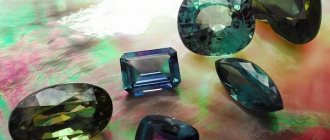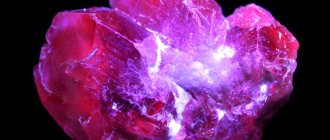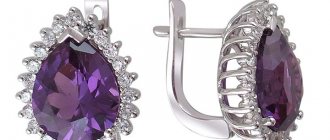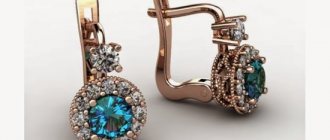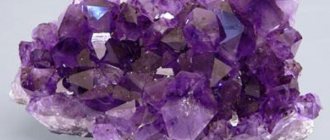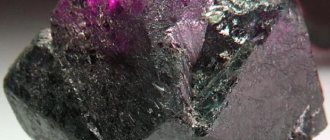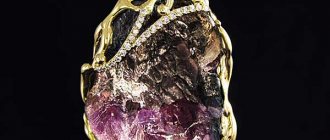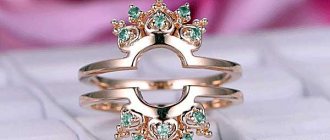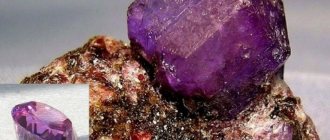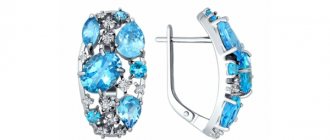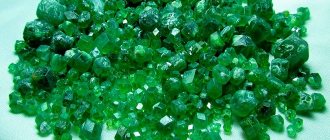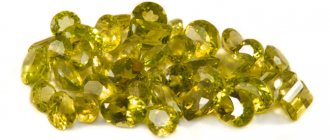It is impossible to say exactly how much alexandrite costs due to the extreme rarity of the stone and the huge number of fakes sold under the guise of this crystal. Capable of changing colors depending on the type and direction of lighting, the mineral is extremely popular among collectors. The price of a Ural alexandrite (weight 21 carats), which was sold at the Christie's auction, was $1.5 million (70 thousand per carat), which is significantly higher than the average cost of diamonds.
Color Changing Gem
Alexandrite is a type of chrysoberyl whose chemical formula is BeAl2O4. If chromium atoms are present in the crystal lattice, it acquires a green color, very similar to emerald.
The main external difference between this gem and emerald is pleochroism, that is, the ability to change the color of its faces depending on the lighting. Under bright sunlight, alexandrite stone is green with a blue tint, and in the light of artificial lamps it turns purple-red.
Natural alexandrite is also characterized by intermediate color shades, when the crystal glows orange-yellow. Read more in the article “Alexandrite stone color”.
This mineral has high hardness, the coefficient of which on the Mohs scale is 8.5 units (for emerald 7.7-8 units). Such characteristics make the crystal extremely wear-resistant, which allows items inlaid with alexandrite to be stored for a long time.
STONE CARE
Alexandrite is a hard stone and is great for everyday wear. However, it is better to store it in a separate place - a box or bag, so as not to damage other, softer stones. Alexandrite should be protected from shock, contact with cosmetics and household chemicals.
Alexandrite can be cleaned using:
- warm soapy solution;
- pair;
- ultrasonic cleaners;
- soft cloth or brush.
The magic of the imperial stone
The unusual stone, capable of changing color from green-blue to purple-red, was given to the heir to the Russian imperial throne, Alexander II, for his 16th birthday in 1834. In honor of the young man, the mineral mined in the mines of the Urals was named alexandrite.
Over the course of several decades, the “imperial stone” gained enormous popularity among the Russian nobility, and was sold abroad for more than a diamond of the same size.
Alexander II made the stone his talisman. He wore the ring with it until his murder by terrorists in 1981. Perhaps because of this, magical properties began to be attributed to the mysterious crystal, considering it a harbinger of trouble. During the First World War, a large number of men died whose wives wore items with alexandrite, which is why the stone was called “widow’s stone.”
Read more in the article “Widow's Stone: Why Alexandrite is Called the Stone of Loneliness.”
Story
Discovered by Nils Nordenskiöld, a mineralogist originally from Finland. In 1834, an unusual green pebble appeared before his eyes.
The man mistook it for an emerald. But the characteristics of the find differed from those inherent in the emerald. Thus, the mineral found turned out to be much harder (8.5 on the Maos scale).
Then the scientist decided to take a closer look at the gem and brought it to the candle flame. Suddenly the stone changed color and became bright red. The transformation of the crystal amazed the mineralogist.
On this day, Alexander II celebrated his birthday. The stone was named after the date of birth of the royal person.
People first started talking about stone in Russia in the 30s of the 19th century. Then the richest deposits were discovered in the Urals. The value of the deposits is proven by the time period during which the minerals were mined. The mines were closed only in 1995.
Experts say that the development of deposits is not related to the fact that there are no more minerals in these places. It’s just that the gems are so deep from the surface of the earth that it is not possible to get them.
Despite intensive searches, it was not possible to discover new deposits.
Impact on the health and physical condition of the owner
Capable of changing color, the crystal immediately attracted the attention of magicians, who began to use it for rituals. The only problem with the alexandrite stone was that it was almost impossible to obtain large crystals weighing more than 1-3 carats, and they were incredibly expensive.
It is believed that this unusual mineral symbolizes the elements of Earth and Water. It helps the owner:
- get rid of fatigue and depression;
- brings peace and harmony to thoughts;
- develops creative direction and sharpens intuition.
Multicolor crystal is perfect for Gemini, Aquarius, Pisces and Scorpio. Keeping it with you is not recommended for Sagittarius, Cancer and Virgo, for whom this beautiful stone brings bad luck. Read more about the magical meaning of the crystal in the article “Alexandrite: properties of the stone and who it suits according to their zodiac sign.”
Remember that you can only wear jewelry with alexandrite during the day; at night, the crystal absorbs the energy of its owner.
HEALING PROPERTIES
The French mystic E. Leo saw a connection between the dual color of alexandrite and a similar property of human blood - arterial and venous. Further experience of healers proved that alexandrite is indeed capable of normalizing the process of hematopoiesis, cleansing blood vessels, and strengthening their walls. This stone is often recommended to people who want to get rid of varicose veins. Wearing alexandrite jewelry helps in the treatment of diseases of the pancreas, spleen, small and large intestines, and protects against scabies and leprosy.
In India, alexandrite is considered a precious mineral that can give longevity. The mineral helps get rid of alcohol addiction. For those who want to cure chronic alcoholism with the help of alexandrite, it is recommended to put it in a vessel with water at night, and take it out in the morning, after which take a couple of sips. Alexandrite has a beneficial effect on the state of the nervous system and human psyche. It has a unique ability to balance emotions and mind, calms nerves, normalizes sleep, promotes concentration and intense mental activity. It should be remembered that only natural minerals have medicinal properties. Artificial alexandrites are not able to influence the human condition. Lithotherapists recommend that people suffering from various diseases or simply wishing to gain inner balance wear jewelry and amulets with alexandrite. However, they remind you that they must be removed at night.
A rare mineral with a rich history
During the years of Soviet power, alexandrite, whose deposits were located exclusively on the territory of the USSR (Ural), was recognized as the property of the republic and its sale in the country was completely prohibited.
All gems mined in the Ural mines were sold abroad, replenishing the state budget. As a result of expropriation, most of the alexandrite jewelry was confiscated and also sold abroad.
This mineral was mined in the Soviet Union and the Russian Federation until 1995, after which the depleted mines had to be closed and crystal mining ceased.
In Russia, the mining of alexandrite is under state ban, and Ural gems can only be purchased illegally. But this will definitely lead to problems with the law.
The world jewelry market sells minerals with similar chemical compositions from Sri Lanka, Brazil, Tanzania, India, and Thailand, which are significantly inferior in color characteristics to Ural gems.
Read more in the article “Where alexandrites are mined.”
How to care for a mineral
Alexandrite is a durable mineral that is easy to care for. Only a diamond is stronger than this stone, so it is difficult to split or scratch it. However, alexandrite should be stored separately from other gems to avoid damaging them.
The mineral is susceptible to alkalis and acids, so it should be protected from chemical solutions containing these components. It is recommended to remove jewelry with stones when washing and cleaning using cleaning products.
Alexandrite does not require frequent cleaning. Once every few months it is rinsed with running warm water. Dirt from the surface of the gem is removed with a soft brush and liquid baby soap. Dry the stone with a soft cloth. Ultrasound can also be used to clean alexandrite.
What affects the cost of a crystal?
The cost of alexandrite, like other precious stones, is determined by its carat weight, color, and level of purity. The type of cut is less important, although it is also taken into account when determining the price.
Natural alexandrite, mined in the Urals, is considered the standard of beauty and sells for between 20 and 35 thousand US dollars per carat. It is almost impossible to buy it in a jewelry store, and the display cases contain mostly synthetic crystals or low-quality stones mined outside our country.
Alexandrite is a rare stone. The saturation of its color depends on the concentration of chromium atoms. The crystals mined in Sri Lanka are most similar in color to Ural gems, but they have a less saturated red color under artificial light.
Brazilian and African stones have a richer brown glow, which significantly reduces their cost.
The average cost of 1 carat of alexandrite from these countries does not exceed $200-500 per carat. This makes the stone accessible to middle-class people.
HOW TO DISTINGUISH FROM A FAKE
The most important distinguishing feature of alexandrite from any fakes and imitations is its amazing and unique ability to change its color. It is this that is decisive when choosing a gem. In this case, you should pay attention to the purity of color under different lighting conditions. Fakes always have extraneous reflections: in daylight they are red or purple, in artificial light they are green. It is also worth paying attention to the presence of inclusions and defects - natural for natural stone.
The influence of the degree of pleochroism on the price
Alexandrite is one of the five most expensive gems in the world. Only diamonds, emeralds, sapphires and rubies can compete with it.
Due to the rarity of the stone, prices for the largest and purest crystals can exceed the cost of a diamond, and stones of low quality are sold much cheaper.
Of great importance is the degree of color change, which in jewelry production is called reverse, as well as the deposits where the gems came from for cutting.
Alexandrite is characterized by an intermediate third glow. If rays of daylight and artificial lighting simultaneously fall on the crystal, then yellow-orange shades appear, which are not typical for painted glass, synthetic and natural stones sold under the guise of this gem.
Alexandrite and zodiac signs
Astrologers attribute alexandrite to the elements of Earth, Water and Ether. It is believed that its energy is influenced by two opposing planets - Saturn and Mars.
Gemini, Scorpio, Leo and Aquarius can tame such a complex stone. People born under these constellations have strong, complex characters, and often experience conflicting emotions, corresponding to the magical qualities of alexandrite. But this does not mean that alexandrite is contraindicated for other zodiac signs.
- Geminis have a fickle, changeable character. For them, alexandrite will be the best assistant in finding inner balance, while the stone will not suppress the versatile interests of the twins.
- Scorpio, who is a born fighter, will be able to cope with any challenge thanks to alexandrite. By overcoming them, he will be able to reach the next stage of spiritual development.
- For Leo, alexandrite will become a talisman leading him to success and power.
- Aquarius, with the help of alexandrite, will be able to strengthen their creative abilities and extraordinary intuition.
Alexandrite can also be worn by Aries, Libra, Sagittarius, Capricorn and Pisces.
- Aries will receive protection, good luck and help in various endeavors from the stone.
- Sagittarius - self-confidence.
- For Libra, the stone will stimulate creativity and help in business.
- Capricorn will be helped with intuition and finances.
- Pisces will often be lucky.
However, if the owner of this stone, despite all the recommendations, feels uncomfortable with it, astrologers strongly recommend getting rid of it.
It is highly undesirable, even contraindicated, for Virgo, Taurus and Cancer to interact with alexandrite.
Prices on the Russian market
Natural alexandrites mined outside our country are widely represented in online stores and jewelry stores that offer crystals from Sri Lanka, India, Thailand, and Madagascar. Brazilian and Tanzanian stones are rare in our country.
Russian sellers offer to buy, for example, a crystal cut in the form of a baguette, measuring 4.5x2.9 mm and weighing 0.27 carats from South India at a price of 35 thousand rubles. A heavier stone of 0.36 carats costs 45 thousand. Oval alexandrite (0.5 ct) is sold for 95 thousand rubles.
A crystal from Madagascar (oval 6.7x5.6 mm, weight 1.42 ct) costs 22,750 rubles, and a drop-shaped gem from the same island weighing 2.3 ct and measuring 9.3x7.1 mm is sold for 36,700 rubles.
Considered more expensive, a crystal from Sri Lanka, cut in the form of a drop, weighing 0.99 carats and measuring 7.5x5.5 mm, can be purchased for 190 thousand rubles.
Remember that the cost of natural stones is directly affected by the degree of reverse (pleochroism) or the ability to change color from green to red.
Factors shaping cost
The most important parameter influencing the price is the origin of alexandrite , and they can be synthetic or natural.
There are 2 ways to obtain alexandrite artificially:
- Grow and form a crystal from scratch .
- A cheaper way is to enrich the base of another mineral with vanadium or chromium .
Very few natural stones are mined. Not all mining sites can boast valuable specimens or simply good quality.
collectors and famous jewelry houses can afford beautiful natural alexandrite . People of average income will be able to purchase only cheap, low-quality specimens that will not reveal the full beauty of this crystal. Therefore, if the buyer does not belong to the category of millionaires, it is better to purchase high-quality artificially grown alexandrite.
The final cost of this type of chrysoberyl depends on the following factors:
- Color , alexandrites with 100% reverse (the ability to change color) are the most expensive.
- Cleanliness , good specimens are always transparent, but only synthetic ones without cracks and natural inclusions are available.
- Weight is the basis of cost. The more, the more expensive. Stones weighing more than 2 carats are very rare.
- Cut also plays an important role in determining the price.
An abundance of artificial jewelry
In order to saturate the market with jewelry with popular crystals, the production of synthetic stones has been established. Artificial alexandrite is grown in laboratory conditions, but due to the structural features of the crystal lattice, it very rarely weighs more than 1-3 carats.
Since the 80s of the last century in the USA, Californian specialists began supplying very high quality synthetic stones to the jewelry market. In color and chemical characteristics they resemble Ural gems, but have virtually no natural inclusions and look much more presentable. Read more in the article “About grown alexandrites”.
For a long time they were sold at the price of natural stones, but in recent years manufacturers have been required to provide a quality certificate and must indicate the origin of the crystal. This allows buyers to make an informed choice between natural and artificial crystal, and not become a victim of banal deception.
Despite the fact that artificial stones look more expensive than real ones, their cost does not exceed $400-500 per carat.
Gemstone mining
The only Russian deposit is located in the Urals in the village of Malyshevo.
Ural enterprises process up to 94 thousand tons of rock per year. Up to 100 grams of alexandrites are released daily, not counting emeralds and beryls.
Sri Lanka is considered the second largest producer of minerals named after the Russian emperor after our country. Alexandrites are mined here every day from alluvial deposits.
The Brazilian deposit was discovered in the 80s of the last millennium. Within a few years the mines were devastated. Today, alexandrites are found rarely, sporadically.
Mining is also carried out in several other parts of the planet. Let us note the countries where we managed to find mines:
- Madagascar;
- Tanzania;
- Kenya;
- India.
Sri Lanka has the largest deposit of alexandrites. A sample weighing almost 400 carats was also found here. This is the most valuable of the raw minerals.
Compatibility with other stones
The “Imperial” crystal is one of the rarest Water stones, which is friendly with Fire. This is the only mineral of the Water element that is compatible with the centers of Fire - diamond and ruby.
After the death of Alexander II from a Narodnaya Volya bomb, it became fashionable among the nobility to combine alexandrite with two diamonds, symbolizing both the “serial number” of the deceased tsar and his two most important causes - judicial reform and the abolition of serfdom.
But it does not combine with other fire gems - garnet, grossular, heliodor. He also doesn’t like Air stones:
- uvarovite;
- demantoid;
- amethyst;
- pink and smoky quartz;
- rhinestone;
- topaz;
- amazonite
An arrangement with Earth minerals is acceptable, but only with the most expensive of them - jadeite, turquoise and the best specimens of onyx and chalcedony. The “widow’s stone” is not worn with cheap jasper, cacholong, or jet.
Alexandrite stone
The best combination of alexandrite is with its native Water minerals, especially emerald. Suitable opals include black, sapphire, moonstone, premium pearls, and all types of beryl except gold.
Is Alexandrite a widow's stone or a stone of loneliness?
Alexandrite was nicknamed widow's in the countries of the former USSR. At the beginning of the twentieth century, the production of artificial alexandrites began in the Soviet Union, and in the thirties this gemstone reached the peak of its popularity. Almost every woman wanted to have jewelry with synthetic alexandrite. Men bought them as gifts for their lovers.
During the Great Patriotic War, many owners of the precious stone were widowed. Human rumor linked the fact of their widowhood and loneliness with the magical properties of alexandrite. The reputation of a beautiful gem was undeservedly tarnished. For many years, the notoriety of a stone that brings loneliness was attached to it.
However, the splendor and mystery of alexandrite continued to excite secular beauties. In order to prevent the evil prophecy from coming true, it was customary to wear this stone in pairs in earrings and sets, or to combine it with other varieties of beryl. Nowadays, exquisite jewelry with alexandrite has regained its well-deserved recognition. Back to contents
